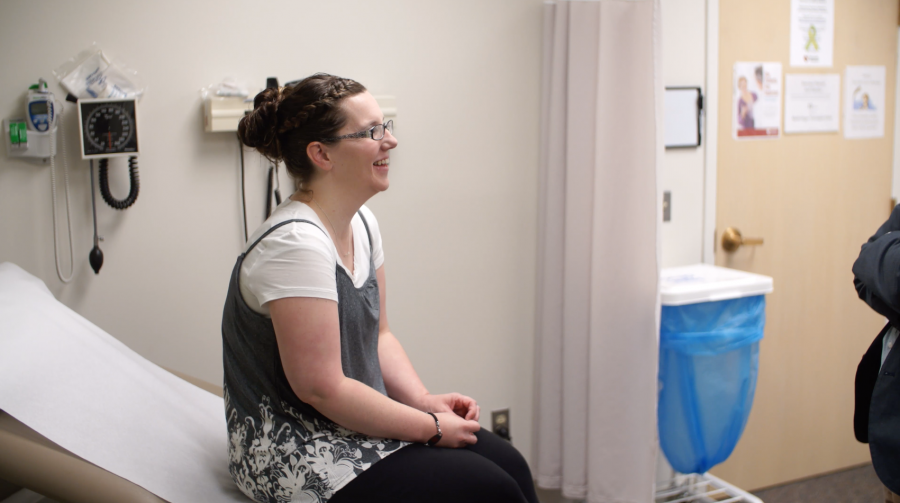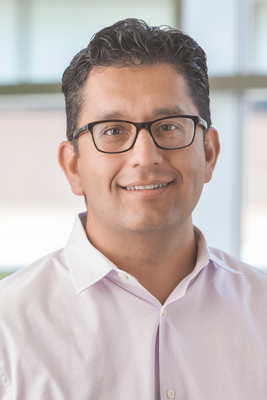
Life was good for Becky Smith. She had given birth to healthy twin girls several months earlier and was enjoying motherhood.
Then the pain started. It was a sharp pain under her rib cage. Then sweating and vomiting. “The pain was unbelievably bad,” recalls Smith. After several visits to her doctor, Smith had her gallbladder removed.
The pain subsided temporarily, but then it came back again, fiercer than before. Smith couldn’t keep food down. It became so bad that she was eventually put on feeding tubes. Smith went to a half dozen doctors or more, but still she had no answers.
Then one of the doctors told her about the Nebraska Medicine Pancreas Disease Program. The only program of its type in the region, our doctors specialize in the diagnosis and treatment of both malignant and non-malignant pancreatic and biliary disorders, one of those being chronic pancreatitis. The clinic brings together the expertise of gastroenterologists, endocrinologists, surgeons, nutritionists, nurse coordinators and social workers, who collaborate and develop a personalized plan of care for each patient.
Help for Pancreatitis
Nebraska Medicine has specialists dedicated to the treatment of pancreas disorders. If you're not getting relief, schedule an appointment for a comprehensive evaluation at 800.922.0000.

Smith met with surgeon Luciano Vargas, MD, who specializes in diseases of the pancreas, liver and bile ducts. After a complete evaluation by the other specialists in the program, Dr. Vargas and his colleagues recommended a total pancreatectomy with auto islet cell transplant. "We all weigh in for each patient, providing three distinct perspectives to come up with a long-term plan of care that is concise, well-thought and employs a very efficient use of the patient's time," says Dr. Vargas. "We're here to help the patient manage the disease through their entire life."
About 80,000 cases of acute pancreatitis occur in the United States each year. While many cases will resolve on their own, about 20 percent of cases are very severe and can be life-threatening. If the pancreas becomes scarred during an attack, the damage will continue, worsen and progress to chronic pancreatitis. “Patients often have chronic pain, frequent flare-ups and may need repeated hospitalizations,” says Dr. Vargas. “It can become a debilitating disease. Many patients aren’t able to work because the pain is so severe.”
There is no cookie-cutter plan for treating acute or chronic pancreatitis. Each patient is different in how quickly the disease progresses, their pain levels and frequency of episodes and how well they respond to pain medications and other treatment modalities, notes Dr. Vargas.
After all medical and endoscopic approaches have been exacerbated, removal of the pancreas (pancreatectomy) with an autologous islet cell transplant, a procedure performed at only a few medical centers in the country, may be considered. In Smith’s case, her condition had progressed to the point where other therapy was no longer an option.
The procedure involves removing the pancreas, then harvesting the islet cells from the pancreas and transplanting them back into the liver. This allows the liver to take over the pancreas’s job of producing insulin and prevents a patient from developing diabetes. The transplant procedure is considered a superior option to a pancreas transplant as it uses the patient’s own islet cells, which eliminates problems with rejection and other complications. Dr. Vargas and his team, who are the only regional specialists, say that it can literally change a person’s life.
Smith can vouch for that. She had the transplant in November 2014, and was able to go back home to Spanish Fork, Utah in January. “I’m happy, healthy and have the strength to do all of the things I want to do and I’m not sick all of the time anymore, says Smith.
“I’ve learned that you should never lose hope. Keep searching until you find someone who can help you. Dr. Vargas and his staff has been so supportive. He helped me get through this and back home again. I have my health and I can thank Dr. Vargas for that.”